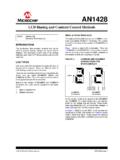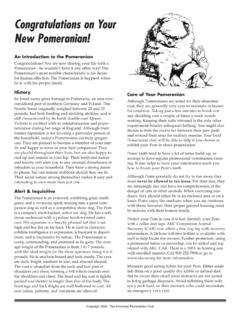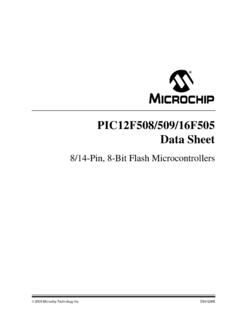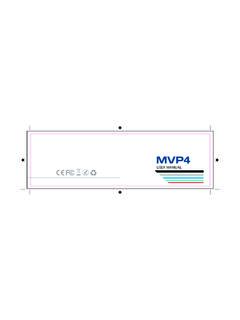Transcription of Programming a PIC Microcontroller - karadev.net
1 Programming a PIC Microcontroller A Short Tutorial by Yesu Thommandru Iowa State University ECpE November 2006 Programming a PIC Microcontroller Page ii of 24 Table of Contents Table of Contents .. ii Revision Record .. iii 1. Document Intended Audience and Reading 2. Choosing a PIC Microcontroller ..3 Types of 3. Integrated Development 4. Programming 5. Compiler, Assembler, and Linker ..6 6. Using MPLab 7. Writing 8. The Burning 9. Breadboarding a PIC Microcontroller ..18 10. Other Programming a PIC Microcontroller Page iii of 24 Revision Record Name Date Reason For Changes Version Yesu Thommandru 11/17/06 Started tutorial Yesu Thommandru 11/18/06 Finished majority of tutorial Yesu Thommandru 11/19/06 Added breadboard images, finished and posted tutorial on Dec06-04 website.
2 Programming a PIC Microcontroller Page 1 of 24 1. Introduction Purpose The purpose of this document is to provide a simple, easy to use tutorial on Programming PIC microcontrollers . The tutorial begins with instructions on selecting a specific PIC and ends with directions for breadboarding the Microcontroller . Document Conventions In this document different styles of text and visuals are used to help the reader separate different types of information. General description text will be in this format, size 11 italicized Arial. Pseudo-code or source code will be written in multi-color, size 10 Courier New font as in the following example: #include < > void main(int argc, char *argv[]) { printf("Star Wars!\n ); return; } Buttons and menu items will be in standard Arial text such as Button with the first letter underlined.
3 Important notes and pieces of information will appear in normal text in shaded boxes as in the following example: NOTE: I think Darth Vader would win in a fight against Boba Fett! Intended Audience and Reading Suggestions The intended audience of this document is students in the Department of Electrical and Computer Engineering enrolled in EE/CprE 491 or 492 Senior Design. This document can also be used by any student or individual who wishes to learn the basics of how to program a PIC Microcontroller . There are a number of suggested readings for any users of this document. The following books are suggested for specific PIC Programming tasks: Introduction to microelectronic systems: the PIC 16F84 Microcontroller by Martin Bates. PIC Microcontroller : an intro to software and hardware interfacing by Han-Way Huang.
4 The PIC Microcontroller : your personal introductory course by John Morton. PIC Microcontroller project book by John Lovine. Programming and customizing the PIC Microcontroller by Myke Predko. The quintessential PIC Microcontroller by Sid Katzen. NOTE: In my experience most of software in these books is written in Assembly and are thus not useful to students wishing to program in a high-level Programming language. Programming a PIC Microcontroller Page 2 of 24 References Schildt, Herbert. C/C++ Programmer s Reference 2nd Edition. McGraw-Hill Publishing. New York, 2000. Morton, John. PIC Your Personal Introductory Course. Newnes. Boston, 1998. Bergquist, Carl. Guide to PICMICRO microcontrollers . Sams Technical Publications. Indianapolis, 2001. Predko, Myke. Handbook of microcontrollers . McGraw-Hill Publishing.
5 New York, 1999. Predko, Myke. PICM icro Microcontroller Pocket Reference. McGraw-Hill. New York. 2000. Smith, PIC in Practice. Newnes. Oxford. 2002. PIC16F877A. 2006. < > PICM icros and C < > Best Microcontroller Projects < > Programming a PIC Microcontroller Page 3 of 24 2. Choosing a PIC Microcontroller Introduction PIC microcontrollers are popular processors developed by microchip Technology with built-in RAM, memory, internal bus, and peripherals that can be used for many applications. PIC originally stood for Programmable Intelligent Computer but is now generally regarded as a Peripheral Interface Controller . Types of PICs PIC microcontrollers are broken up into two major categories: 8-bit microcontrollers and 16-bit microcontrollers . Each category is further subdivided into product families as shown in the following table: 8-bit MCU Product Family 16-bit MCU Product Family PIC10 PIC12 PIC14 PIC16 PIC18 PIC24F PIC24H dsPIC30 dsPIC33 The microcontrollers in the PIC10 through PIC14 families are considered low-end microcontrollers .
6 PIC microcontrollers in the PIC16 and PIC18 families are considered mid-level microcontrollers while 16-bit PICs are considered high-end microcontrollers . NOTE: The majority of students and projects will require mid-level microcontrollers . The most popular PIC used in senior design is the PIC16F877/A. Each PIC has unique features and subtle differences. The correct choice for your project depends on many factors: Does the project require analog input or output? Does the project require digital input or output? How many I/O pins are required? Does the project require precise timing? How much memory does the project require? Is serial I/O required? Etc. PICs also come in several types of packages: Plastic Dual Inline Package (PDIP) Small-Outline Transistor (SOT) Dual Flat No-lead (DFN) Mini Small Outline Package (MSOP) Thin Quad Flat Pack (TQFP) Plastic Leaded Chip Carrier (PLCC) CERamic QUAD pack (CERQUAD) Programming a PIC Microcontroller Page 4 of 24 The reason for the number of packages is that there are some PICs with 100 I/O pins!
7 The microcontrollers are basically rectangular or square shaped. The easiest package to work with is DIP or PDIP because it is easily breadboardable and can easily be soldered. NOTE: Use a mid-level dual inline package PIC Microcontroller . You will not be able to burn software into a QUAD chip and SOP chips will require Schmartboards. 3. Integrated Development Environment In order to develop your software and organize your files you will have to use an integrated development environment. The number one IDE used with PIC microcontrollers is MPLab IDE by microchip Technology. MPLab IDE is free and easy to use. Just go to to download the latest version. NOTE: The latest version of MPLab IDE ends in zero. Files not ending in zero are interim versions of MPLab IDE. You can also download the MPLab IDE User s Guide, Quick Chart, and Quick Start Guide.
8 After you have downloaded the latest version of MPLab IDE install the software on your local drive. 4. Programming Language PIC microcontrollers can be programmed in Assembly, C or a combination of the two. Other high-level Programming languages can be used but embedded systems software is primarily written in C. The following three examples demonstrate the Programming styles. Example 1 Assembly MAIN clrf PORTB ;Clear PORTB output latches bsf STATUS,RP0 ;Switch to bank 1 movlw b'11110000' ;Load value to make lower 4 bits outputs movwf TRISB ;Move value to TRISB bcf STATUS,RP0 ;Switch to bank 0 LOOP bsf PORTB,0 ;Turn on LED on RB0 call DELAY ;Call delay routine bcf PORTB,0 ;Turn off LED on RB0 call DELAY ;Call delay routine goto LOOP ;Repeat main loop DELAY decfsz COUNTERL ;Decrement COUNTERL goto DELAY ;If not zero, keep decrementing COUNTERL decfsz COUNTERH ;Decrement COUNTERH goto DELAY ;If not zero, decrement COUNTERL again return END Programming a PIC Microcontroller Page 5 of 24 Example 2 Assembly and C main() { short first_pass = TRUE.}
9 //----- Set up port direction reg's ----- #asm movlw 0 // Set port b to outputs tris port_b clrf port_b movlw 0xff // Set port a to inputs tris port_a #endasm //----- Wait for powerup, Initilize LCD ----- delay_ms(200); init_lcd(); //----- Write a startup message ----- msg_1(); //----- Write status message ----- msg_2(); .. Example 3 C void main() { U8 i = 0; // General purpose loop var. U16 num ; // General purpose number var. U8 row = 0; // Current display row. U16 blinkc = 0; // LED blinker counter. U16 blink_onoff = 1; // LED state. U8 bcd_h,bcd_m,bcd_s; // BCD numbers. init_ports(); init(); enable_interrupts(); ROW_RESET; ///////////////////////////// for (;;) { // infinite loop // FLASH LED @ RA3 if (++blinkc>500) { // time to change state ?}}}
10 Blinkc=0; .. I suggest writing your code completely in C because it is much faster and easier than writing your code in Assembly or a combination of languages. NOTE: The version of C that you use to write you software will depend on the C compiler you choose to use in your project. Programming a PIC Microcontroller Page 6 of 24 5. Compiler, Assembler, and Linker Once you have downloaded and installed MPLab IDE and chosen a Programming language you will have to select a compiler. The compiler, assembler, and linker are usually combined in a single package. In MPLab IDE you can choose you compiler by using the Project Wizard or selecting the menu option Project Select Language Toolsuite. The following image shows some of the available toolsuites in MPLab IDE: Most of the toolsuites are NOT preinstalled and are quite expensive.










